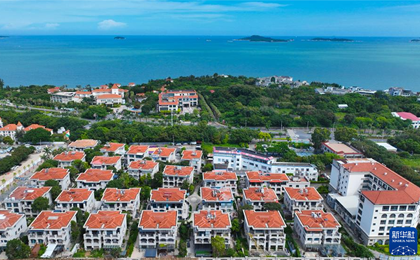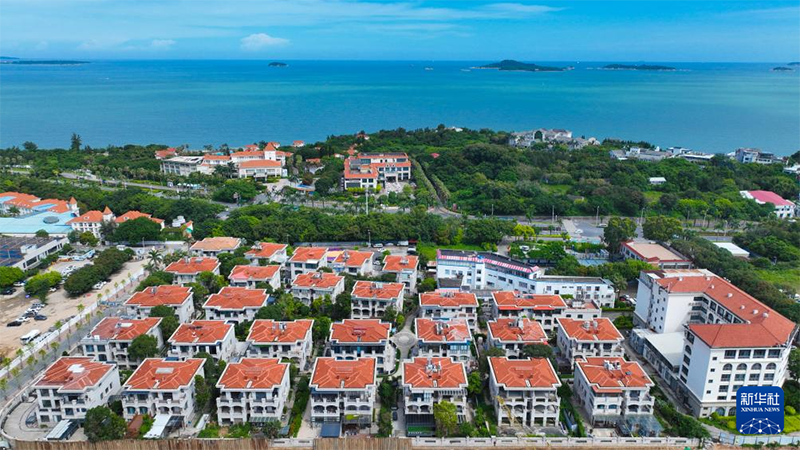



▲ Urban village of Tatoushe in Huangcuo Community, Siming District, Xiamen City. [Xinhua/ Zhou Yi]
3. Integrating Urban Village Renovation Requirements into Territorial Planning.
The formulation and implementation of territorial planning should refine the work content and management requirements for urban village renovation based on urban development goals, characteristics, and development needs of existing stock. For cities where comprehensive planning has been formulated but urban village renovation tasks are not yet specified, arrangements should be made in the detailed and short-term construction planning.
3.1 Strengthening spatial coordination at the comprehensive planning level.
All localities should specify the planning objectives, key areas, processes, and timings for urban village renovation in the comprehensive territorial planning according to local conditions. This aims to enhance the city’s level and core competitiveness, promote more coordinated urban-rural and regional development, and advance national strategies.
(1) Define renovation targets and key areas.
According to the requirements for eliminating various safety risks and promoting high-quality urban development, set the targets for urban village renovation.
Identify key renovation areas based on the needs of territorial planning implementation, categorizing renovation methods as demolition and rebuilding, improvement and upgrading, or a combination of demolition and renovation. Prioritize the renovation of urban villages in key functional areas and key development clusters identified by territorial planning. Focus on urban villages with significant safety risks, poor landscapes, and notable infrastructure deficiencies. Moreover, consider urban villages that are compliant with planning requirements and have policy support and market incentives for renovation.
(2) Make proper timing arrangements.
For comprehensive planning that has been formulated but does not yet specify urban village renovation tasks, the short-term construction planning should be formulated to implement the comprehensive planning, aligning with the plans for national economic and social development, and arrange implementation schedule.
Based on the city’s recent development targets, set the five-year planning objectives and tasks for urban village renovation. Define the short-term scope of urban village renovation for key areas and encourage prioritization of urban villages in key urban zones that are more feasible and urgent for renovation. Integrate this with land allocation plans and implementation schedules. Based on the scope of short-term renovation, develop a list of implementation projects, allowing for planning flexibility and feasibility. Specify renovation scales, methods, and annual timelines to guide the formulation of annual urban village renovation plans.
3.2 Refining territorial management requirements at the detailed planning level.
All localities should reasonably determine the urban village renovation units based on the urban village renovation methods, detailed planning and management practices, work organization arrangements, and the current property ownership relationships. These renovation units should be divided into “planning units” and “implementation units.” The planning and approval processes should be carried out in a leveled and graded manner. Alternatively, depending on the needs of the work, the planning and approval can be integrated and approved simultaneously in accordance with regulations.
(1) Detailed planning of the planning unit specifies the control requirements.
The detailed planning for urban village renovation planning units should be based on comprehensive planning, decomposing and implementing related requirements, defining the development positioning, primary functions, and total building scale, and proposing rigid control and distinctive guidance requirements. This detailed planning of the planning units serves as the basis for the preparation of detailed planning for implementation units and should emphasize the following aspects:
·Addressing facilities gaps.
Make full use of existing facilities, address gaps in supporting infrastructure, optimize the layout of affordable housing, and create a 15-minute community life circle. Ensure connectivity and sharing of facilities inside and outside the unit, and coordinate with neighboring areas for facility integration.
·Strengthening urban design and landscape control.
Propose important urban design elements such as building height, skyline, major landscape nodes, green space systems and open spaces, wind corridors, and characteristic landscape controls.
·Establishing positive and negative lists.
Include renovation projects that help optimize urban spatial structure, enhance industrial development levels, improve urban functions, shore up weak links in infrastructure, promote ecological conservation, protect and revitalize historical and cultural heritage in the positive list, and encourage prioritized renovation. Develop a negative project list for planning supervision with special protection needs or those that should not involve large-scale demolition and construction, and strengthen the timely handling of issues listed in the negative list.
Source:
<https://www.gov.cn/zhengce/zhengceku/202407/content_6964732.htm>
Editor & Translator: GUO Xinxin